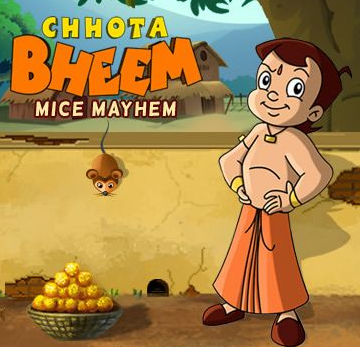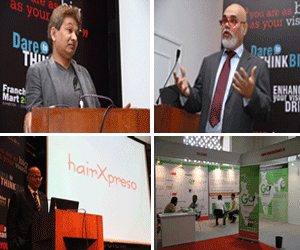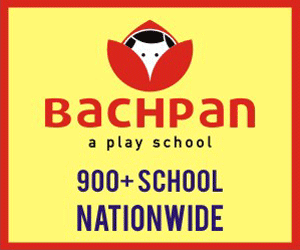The kid avatar has made its parent Green Gold’s stories more saleable to networks.
You would have to have lived in total isolation for the past five years to not notice the distinctly Indian phenomenon called Chhota Bheem – an animation show on children’s television channel Pogo – that has taken the children’s entertainment industry by storm.
In just five years, Chhota Bheem – named after the 9-year old character in the television series created by Rajiv Chilaka – has spawned comic books, T-Shirts and DVDs, all of which have sold briskly. The franchise has also led to a torrent of licensing and merchandising activity. Everything from tiffin boxes, water bottles, toys to food products, such as fruit drinks and wafers sport the series’ characters.
Large companies such as Usha Fans have also plastered Bheem and friends on their products. This has allowed Chilaka’s company, Green Gold, to amass Rs 30 crore in revenue in 2011-12, 40 per cent of which came from these deals. “It’s been a very remarkable story,” says Krishna Desai, senior director & network head (kids), South Asia, Turner International.
Franchise gold
All of this, of course, is due to the 148 episodes of the 30-minute serial that have attracted 40 million viewers and provided a springboard for several other TV and feature films. Chhota Bheem (little Bheem) became the first Indian brand of which McDonald’s distributed toys as a promotional event in the run-up to the franchise’s second animation feature film, ‘Chhota Bheem and the Throne of Bali,’ in a cashless, quid-pro-quo deal.
The story promises to continue in the form of Chilaka’s next big play – a fictional series loosely-based on yet another mythological character, Arjun, who had a cameo in ‘…Bali.’ “If Bheem is Salman Khan then Arjun is Ranbir Kapoor. He’s stylish, gives a damn what people think and girls fall for him,” says Chilaka, who adds that he has pre-sold the series to Disney.
Chilaka has come a long way considering he had no connection to either the film or the television industry. After heading to the US for his Masters in Engineering at the University of Missouri, he realised he wanted to do something else. “I had an inclination towards storytelling but felt my strengths were a mix of technology and creativity. So, I felt I was more suited towards animation.” The goal to learn animation became an obsession and Chilaka eventually quit his job to end up at the animation school at San Francisco’s Academy of Arts, working from eight in the morning to two in the wee hours.
Homebound
Upon finishing, Chilaka returned to India where he sensed a big opportunity. “There was a lot of struggle. I borrowed money to pay salaries. It was a hand-to-mouth existence,” he says. He had to resort to designing corporate websites in order to foot the bills. Meanwhile, his company, Green Gold, produced ‘Vikram aur Betaal,’ which was bought by Turner. But the deal was not financially lucrative.
One day, struggling with conceptualising a saleable series, Chilaka happened upon his favourite character in the Mahabharata, Bheem, and thought, “Why not put his younger version in a fictional village?” It was an epiphany. “In 15 minutes, I had all the contours of the show and its characters sketched out,” he adds. But a pilot along with six developed episodes failed to convince Turner’s Cartoon Network and the Disney network.
There were, however, flashes of success that buoyed the company. ‘Vikram aur Betaal’ did well on Cartoon Network and Green Gold’s subsequent television movies on Krishna in 2006-07 did very well. “The channels saw a story-telling ability,” says Chilaka and the wheels of fortune began to turn in his favour. He decided to re-work the look and feel of Chhota Bheem and re-pitched it to Turner. It got picked up as part of Turner’s ‘Desi Toons’ (indigenous cartoons) series to localise more content. Pogo, a laggard at the time, carried the series. In three years, it became the top-rated kids show in India.
“Chhota Bheem played a critical role in Pogo’s success,” says Turner’s Desai. “It has definitely helped us monetise our screen assets on the Internet, phone and television,” he adds.
Children’s shows still command an anaemic 2.5 per cent of advertising revenue despite a 7 per cent share of all the kids channels put together. The pie, though, has grown, from three channels some 13 years ago to 17 today, with six to seven of the dominant ones attracting 90 per cent of the eyeballs. In other words, the time is ripe for projects like Chilaka’s ‘Arjun’ to coast on the success of its predecessor.
But in order to do so, Green Gold may need to keep on top of evolving cultural trends. The phenomenal rise of Japanese anime is one, where ‘Doraemon’ on the Disney Channel is now neck-and-neck with ‘Chhota Bheem’. Other shows such as ‘Shinchan’, ‘Ninja Hattori’ and ‘Kiteretsu’ are also hot favourites.
These are shows produced in Japan in the 1970s that have found traction in India now, possibly because Japanese society with its extended family structures and focus on education at the time still mirrors that of India’s.
Some bloggers have also taken offense to what they say are regressive traits in ‘Chhota Bheem’. For instance, Chutki, one of Bheem’s admirers, is described on the show’s website as ‘simple, graceful and intelligent…loves playing with the boys but is also feminine and involves herself with art and household chores’. She is seldom seen in a dominant role and this is not something that working mothers, for instance, may find very appealing. The show’s bullies – Kalia, based on the evil Duryodhan, and his cronies, Dholu and Bholu – are distinctly darker in shade than any of the show’s more positive characters. Addressing these gender and race issues may help attract fatter wallets in the long run.
These concerns aside, the future for the franchise looks strong. It is currently being exported to elsewhere in Asia, especially Indonesia, further extending its lifespan.
Desai at Turner says, “The brand still has a long way to go. It hasn’t peaked as yet.”
Major stories over the last 30 days































 +91 9909960054
+91 9909960054